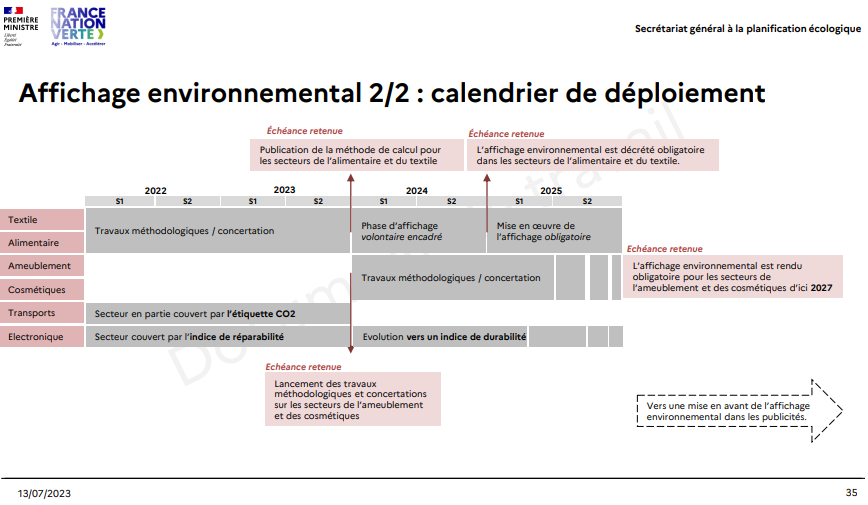Environmental labelling
Environmental labelling (EL) aims to inform consumers about the environmental impact of the products and services they consume.
Using a "numerical value", it allows to reflect the impact of different products on the market, and thus to help consumers choose lower-impact products and services, and encourage producers to produce in a more environmentally-friendly way.
Product labelling applies to all products in a given market sector, as opposed to labels, which only distinguish products that are "better off/meet distinctive specifications". Like price, which reflects the "financial cost" of products, environmental labelling aims to reflect the "environmental cost/cost to the planet" of goods and services sold. The higher the value, the higher the environmental cost.
The format and visuals are currently being defined by the public authorities.
News
The priority for ADEME and the public authorities is to finalize and roll out environmental labelling in the food and textile sectors by 2024. At the beginning of 2024, the final choices and political approvals are expected on the technical aspects, name and format of the system. This information will be posted online as soon as it becomes available. Based on experience feedback, the scheme will be extended in the coming years to cover the main consumer products and services.
Environmental labelling: Background and objectives
It's an "environmental cost index", displayed on products or services, on shelves or on the Internet, calculated over the entire life cycle of the product or service, according to a validated reference system. It's a simple benchmark for consumers (with a registered graphic identity), enabling them to compare products and make an informed choice at the time of purchase.
Environmental labelling encourages manufacturers and distributors to initiate and enhance their eco-design initiatives by providing precise information on the environmental impact of their products.
It is a voluntary and regulated tool for improving the environmental performance of products/services, with a dual objective:
- A system to inform consumers when they make purchases => a simple benchmark to raise awareness of responsible consumption
- A system to encourage manufacturers/distributors to initiate and enhance their eco-design initiatives => a management tool to encourage sustainable production.
Environmental display is an approach promoted since 2009 as part of the Grenelle Environment Forum to raise consumer awareness of the environmental impacts of products and services, taken up by the Citizens' Convention and then in various laws, the latest being "Climat et Résilience de 2021" (Article 2).
LOI n° 2021-1104 of August 22, 2021 stipulates:
"A display intended to provide consumers with information relating to the environmental impacts [...] of a category of goods or services placed on the national market is made compulsory, under the conditions and subject to the reservations set out in Article L. 541-9-12."
"This display [...] is visible or accessible to the consumer, in particular at the time of purchase. "
"The information provided highlights the environmental impact of goods [...] over their entire life cycle, in a way that is reliable and easy for consumers to understand. It takes into account, according to their relevance for a given category [...] greenhouse gas emissions, damage to biodiversity and consumption of water and other natural resources. It also takes into account the environmental externalities of systems [...], scientifically evaluated, in particular for agricultural, forestry and food products."
"Experiments are carried out for a maximum of five years [...] to evaluate different methodologies for calculating environmental impacts and displaying them. At the end of the trials [...] environmental labelling will be made compulsory."
A decree will define the categories of goods and services concerned, the methodology to be used and the display methods selected. The legislator will ensure that the conditions are adapted to the size of the company, in particular for very small, small and medium-sized businesses.
The environmental display system comprises several tools for calculating the "impact score" and ensuring the comparability of results:
General principles and methodological framework: common to all product categories, PEF (European) or BPC 30-323 (French) standards. These standards are based on the Life Cycle Assessment (LCA) framework.
Sector-specific standards: These specify the common standard, explaining how calculations are to be carried out for each product category. They also specify any additions to be made to the LCA indicators (e.g. microplastic indicator for textiles).
A generic LCA database: provides the "default" environmental values required for product impact calculations. Example: impact of electricity, materials, transport, etc. In partnership with ADEME, we are developing the "Empreinte" and "Agribalyse" LCA databases, which are used for display purposes.
Public or private calculation tools to facilitate implementation: e.g. Ecobalyse
The display format: a graphic charter and logo.
Environmental labelling: work in progress and feedback
During this period, 168 companies, distributors and trade associations experimented with an initial display system for everyday consumer products. On this occasion, environmental impact indicators were affixed to certain products.
A report on this nationwide experiment was submitted to Parliament in 2013. The main findings are as follows:
- An experiment that positioned France as a pioneer;
- The interest and relevance of a multi-criteria approach covering the entire life cycle (LCA approach);
- A potential source of economic competitiveness and environmental performance;
- Genuine consumer expectations;
- A need to develop common data and methodologies to better cover all environmental issues (soil carbon, biodiversity, etc.) before validating an official scheme.
Following this initial experimentation, technical work continued at ADEME, via various sectoral experiments and at European level.
Over the 2017-2020 period, five pilot sectors re-tested environmental labelling on their products or services: electronic products, food products, clothing, furnishings and hotels.
The aims of these projects were to
- Calculate the environmental display using the reference systems, the IMPACTS ® database (now Empreinte database) and available tools, and collect feedback,
- Use environmental labelling as a lever to initiate eco-design initiatives,
- Communicate the results of environmental labelling to consumers, and encourage companies in these sectors to take the plunge.
- Provide reports and feedback.
Since 2021, public authorities have focused their resources on the food and textile sectors.
And at European level?
In 2013, the European Commission adopted a recommendation to member states and economic players to use common European methods, known as PEF (Product Environmental Footprint) and OEF (Organization Environmental Footprint).
Governance
The Ministry of Ecological Transition and Territorial Cohesion (Ministère de la Transition Ecologique et de la Cohésion des Territoires - MTECT) is in charge of environmental labelling at the political level, with ADEME as technical operator (MTECT), with ADEME acting as technical operator.
The system is organized according to the usual governance structure: interministerial steering committee, technical secretariat, scientific council and partners' committee.
Deployment schedule - published in summer 2023
This is the timetable published by the General Secretariat for Ecological Planning for the summer of 2023.



